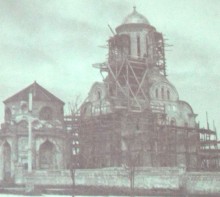Researchers in Chernihiv reveal the secrets from archival documents received by the Fund of National Historical and Architectural Reserve “Ancient Chernihiv.” Part of the archives was provided by the directorate of the JSC “Chernihivproektrestavratsia.” According to scientists, these documents are an invaluable treasure for researchers of antiquities, as well as for architects, conducting repair and restoration of architectural monuments. The geography of places that materials came from is quite impressive. Apart from Chernihiv region it covers six oblasts of Ukraine.
Restoration of some architectural monuments of Chernihiv region was done with the help of these documents. The archives contain plans for arranging conveniences in monasteries, design estimates for repair and restoration of the monuments of architecture and history, general plans of historic towns, numerous albums, and more. The archives contain documents that date back to the early 1950s and end in 2003. Unfortunately, in 2004 “Chernihiv Interregional Scientific Restoration Studio” ceased to exist. That same year two new bodies were created, which shared the archive that was gathered over the long period of restoration works.
The directorate of the JSC “Chernihivproektrestavratsia” gave scientists a part of the archive. This organization is a successor of the interregional scientific restoration studio.
According to Honored Builder of Ukraine, director of “Chernihiv Restoration Studio” Yurii Vialy, at some point “Chernihiv Interregional Scientific Restoration Studio” conducted restoration work on objects all over the left-bank Ukraine and that included seven oblasts: Chernihiv, Sumy, Poltava, Kharkiv, Donetsk, Dnipropetrovsk oblasts and one object in Izmail, Odesa oblast. During this time, restorers revived from obscurity over 150 monuments. Leading architects, researchers, and photographers worked in special scientific and industrial restoration studios.
According to a senior researcher of scientific and museum stock of the reserve “Ancient Chernihiv” Olena Manzhula, restoration project of every building is a small scientific research. It was important to make the architectural dimensions of structures, learn about the history of the object, and process a large number of archival and documentary materials. Most of the projects were conducted by representatives of the “Ukrproektrestavratsia” Institute, which included a large number of professional architects, art historians, and artists.
To discover all the secrets of brick walls making, mortar and building materials used, it was necessary to conduct walls probing and architectural and archaeological research. Extremely valuable exhibit of the collection are photos of the restored monument. Today scientists can compare the state of a monument by looking at those photos.
A striking example of the unique restoration is the Piatnytska Church in Chernihiv. During the war, two thirds of the building was destroyed. It was restored through the efforts of architect Petro Baranovsky. The architect even made sure that one of the brick factories of Chernihiv started production of plinfa (special type of bricks) according to old samples and restored the church in the form it was originally built. On the photos taken in the 1950s it is clear that there was a rotunda next to the church. The rotunda was built in the early 19th century by the provincial architect Anton Kartashevsky. Unfortunately, this building is gone now.
According to Manzhula, one can clearly see the ideological approach to restoration from the example of restoration of the Piatnytska Church. At that time architectural monuments were restored in the forms they had in the ancient period, without paying much attention to the later extensions.
In general, the archive collection received by the reserve contains thousands of documents. According to scientists, the most interesting ones are the documents of author’s observations, when renowned architects put down interesting points of restoration. Scientists still have a lot of work ahead because all the documents need to be systematized and put on the record.
However, the prospects of modern restorers are not very optimistic. According to Vialy, JSC “Chernihivrestavratsia,” which is one of the successors of the interregional scientific restoration studio, hasn’t been involved in any restoration works for several years already. Presently, only LLC “Chernihiv Restoration Studio” works on historical and architectural sites of Chernihiv region.
“Restoration in Ukraine falls into decay,” said Vialy. “A large number of monuments have been leased. State removes the burden of funding from its shoulders despite the fact that many sites need restoration.” Now the restorers receive only about two million hryvnias per year from the state for the restoration work.







